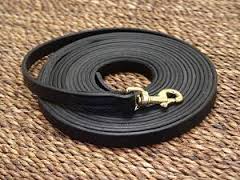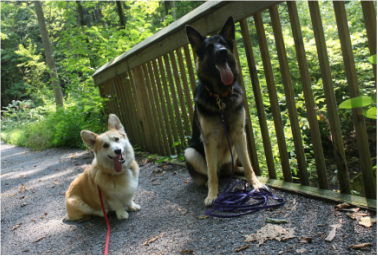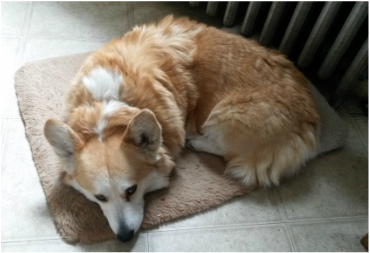Why Using a Long Line Makes a Better Walk For You and Your Dog
|
When I say “long line”, I’m not referring to the metal line that you stake into the ground in your back yard; nor do I mean a retractable leash which is like a shoestring attached to a plastic handle and offers you little control. I mean a 12-15’ leash made of cotton webbing that looks like a regular leash only much longer. Sometimes they are referred to as “training leads” and you can often find them online or in a store packaged wrapped in a spiral. They come in 10’, 15’, 20’, 30’ even 50’ varieties, but 15’ is usually all you need for walking – anything longer is just too much to handle and unnecessary. I use this 15’ long line almost anytime I take my dog out and about. He and I both love the flexibility it offers when used correctly, and it makes for a more pleasant outing for both of us!
|
You can adjust the length of the long line by simply gathering up the excess in your hand when you want or need it to be short, or feeding it out when space allows. It can be shortened to 4 feet when you need to squeeze past a tight sidewalk obstacle, or it can be let out to 12 feet if you are in a field or on a trail.
A walk on a long line allows for more freedom, which makes your dog happy, but you can still control the situation, which makes you happy (and usually results in better outcomes for your dog). You can still work on obedience and real-life skills such as name response, check-ins, walking on a loose leash, and recalls. The walk that ensues will be one about respect, working together, and maintaining an emotional connection (rather than a walk where a dog is feeling managed, which equals more pulling and less fun for all).
Pulling on leash usually occurs because the dog is trying not to be micromanaged, which is what tends to happen when we rely on a 4- to 6-foot leash to give our dog all of our communication (Move here. Don’t touch that. Walk on this. Don’t jump on that person. – all without saying a word). The same thing can happen with a long line if either the dog or the handler hasn’t learned to respect the leash – then pulling is inevitable, and sometimes the handler is even the one causing the tension in the leash. But using a long line to focus on the emotional connection rather than the physical tether between you builds the skill of loose leash walking and allows for a more respectful and enjoyable walk for all involved!
Many dogs, particularly herding breeds, don’t naturally want to walk side by side – they are either leading the herd in front or moving it into place at the back. So rigid heeling on command is more work and takes more focus – great for agility or Rally-O practice but not what you want from a leisurely walk that is going to casually allow you and your dog to get out some energy. Working on a long line can give you a mix of both for everyone’s enjoyment. It doesn’t matter if your dog is 3 paces ahead of you if he is choosing to check in and make eye contact with you on his own accord (without being prompted by you) and choosing you over distractions. You may even find that your dog just enjoys knowing he has the freedom to be 3 paces ahead of you and then doesn’t even need to take it! He just likes being respected, and if you are still the leader on your walk (deciding where to go and what to do), his position doesn’t really matter.
Check out this short video of a long line walk through a local town (featuring Mr. Jones and his dad, Joseph)…
A walk on a long line allows for more freedom, which makes your dog happy, but you can still control the situation, which makes you happy (and usually results in better outcomes for your dog). You can still work on obedience and real-life skills such as name response, check-ins, walking on a loose leash, and recalls. The walk that ensues will be one about respect, working together, and maintaining an emotional connection (rather than a walk where a dog is feeling managed, which equals more pulling and less fun for all).
Pulling on leash usually occurs because the dog is trying not to be micromanaged, which is what tends to happen when we rely on a 4- to 6-foot leash to give our dog all of our communication (Move here. Don’t touch that. Walk on this. Don’t jump on that person. – all without saying a word). The same thing can happen with a long line if either the dog or the handler hasn’t learned to respect the leash – then pulling is inevitable, and sometimes the handler is even the one causing the tension in the leash. But using a long line to focus on the emotional connection rather than the physical tether between you builds the skill of loose leash walking and allows for a more respectful and enjoyable walk for all involved!
Many dogs, particularly herding breeds, don’t naturally want to walk side by side – they are either leading the herd in front or moving it into place at the back. So rigid heeling on command is more work and takes more focus – great for agility or Rally-O practice but not what you want from a leisurely walk that is going to casually allow you and your dog to get out some energy. Working on a long line can give you a mix of both for everyone’s enjoyment. It doesn’t matter if your dog is 3 paces ahead of you if he is choosing to check in and make eye contact with you on his own accord (without being prompted by you) and choosing you over distractions. You may even find that your dog just enjoys knowing he has the freedom to be 3 paces ahead of you and then doesn’t even need to take it! He just likes being respected, and if you are still the leader on your walk (deciding where to go and what to do), his position doesn’t really matter.
Check out this short video of a long line walk through a local town (featuring Mr. Jones and his dad, Joseph)…
A long line is the closest thing to working with your dog off-leash as acceptable in a town or area with leash laws. These leash laws are in place for a reason – they are made to protect you, your dog, other people and even other dogs. Someone who’s afraid of dogs will not want an unleashed dog running up to them unexpectedly, even if you shout out “don’t worry, he’s friendly!” Or perhaps the dog your dog tries running up to doesn’t like pushy dogs coming up into his space uninvited. So for the safety of all involved, PLEASE follow leash laws! Long lines are a great way to do this (IF you utilize them appropriately of course!). You can get your dog to work with you in a way that isn’t reliant on the leash to keep your connection, but it’s there as a safety tool or to limit your dog’s options when necessary (i.e. so he doesn’t jump in that mucky pond or chase the cyclist passing on the street).
Because your dog needs to get energy out (and this may even be the reason you are going for a walk in the first place), a long line allows your dog more space to move about. But a walk isn’t just about physically moving as exercise for most dogs; it’s also about checking out their environment, socialization, and mental stimulation as well. Going for a walk together on a long line allows him to move with you but he can sniff the grass as you walk by to get information or walk around a grate that he chooses not to step on (instead of being pressured to by being on a short leash). When he’s in a good headspace and a calmer emotional state, he’ll get a productive outlet for his energy, as opposed to pulling and lunging and staying in a state of high, unproductive arousal. So you get to train, socialize, and exercise all at the same time!
A long line allows your dog the space he may need to explore new or stimulating surroundings at his own pace and without pressure. He can choose how close or far away he wants to be from some noise or novel object as he takes the time needed for him to process the situation and realize it’s really not that big of a deal. He can build confidence, check that situation off on his list of life experiences, and be better equipped mentally to handle that situation the next time he encounters it. This puts your dog in a good headspace for learning and responding and in a calmer emotional state. When he’s in a calmer emotional state during your walk, you are too (because you don’t have to worry about pulling or any unruly behavior that makes walking a struggle!).
A walk or hike on a long line with another dog is also the most productive way for two dogs to exercise together, especially if one person holds the long line for one dog and another person holds the long line for the other dog. At first you may be unsure how to handle the two long lines, for risk they may get tangled, but the more you practice and calmly direct where the long lines are allowed to go, you will get better and better at this leash handling skill. You may even find that your dog will learn how to untangle himself – a good opportunity to practice problem-solving! This kind of dog-to-dog interaction is much better than allowing them to roughhouse constantly in your living room or small back yard, where many times arousal levels can rise and it can turn from being a productive outlet to an inappropriate and unproductive outlet quickly. My dog loves his long line hikes and walks with his buddies and is always ready to rest afterwards, in a “happy dog” kind of way!
Because your dog needs to get energy out (and this may even be the reason you are going for a walk in the first place), a long line allows your dog more space to move about. But a walk isn’t just about physically moving as exercise for most dogs; it’s also about checking out their environment, socialization, and mental stimulation as well. Going for a walk together on a long line allows him to move with you but he can sniff the grass as you walk by to get information or walk around a grate that he chooses not to step on (instead of being pressured to by being on a short leash). When he’s in a good headspace and a calmer emotional state, he’ll get a productive outlet for his energy, as opposed to pulling and lunging and staying in a state of high, unproductive arousal. So you get to train, socialize, and exercise all at the same time!
A long line allows your dog the space he may need to explore new or stimulating surroundings at his own pace and without pressure. He can choose how close or far away he wants to be from some noise or novel object as he takes the time needed for him to process the situation and realize it’s really not that big of a deal. He can build confidence, check that situation off on his list of life experiences, and be better equipped mentally to handle that situation the next time he encounters it. This puts your dog in a good headspace for learning and responding and in a calmer emotional state. When he’s in a calmer emotional state during your walk, you are too (because you don’t have to worry about pulling or any unruly behavior that makes walking a struggle!).
A walk or hike on a long line with another dog is also the most productive way for two dogs to exercise together, especially if one person holds the long line for one dog and another person holds the long line for the other dog. At first you may be unsure how to handle the two long lines, for risk they may get tangled, but the more you practice and calmly direct where the long lines are allowed to go, you will get better and better at this leash handling skill. You may even find that your dog will learn how to untangle himself – a good opportunity to practice problem-solving! This kind of dog-to-dog interaction is much better than allowing them to roughhouse constantly in your living room or small back yard, where many times arousal levels can rise and it can turn from being a productive outlet to an inappropriate and unproductive outlet quickly. My dog loves his long line hikes and walks with his buddies and is always ready to rest afterwards, in a “happy dog” kind of way!
For more information on how to make the long line work for you - to build your dog's confidence, for dog-to-dog interaction, and/or for productive exercising techniques - contact me at (845) 549-0896 or [email protected].
Written by Maria Huntoon, Maria G. Huntoon Canine Consulting Services









